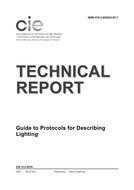Click here to purchase
Lighting quality encompasses human needs, architectural integration and economic constraints (including energy). To develop information about the luminous conditions that will fulfil lighting quality goals in various settings one needs to know how people respond, in the broadest sense, to electromagnetic radiation detected by the eye and processed by various physiological systems. Common definitions and measurement protocols for lighting installations are needed to support this work and to support communication with designers. This guide, the work of CIE Technical Committee 3-34, establishes a catalogue of application-independent descriptors of lighting and protocols associated with each descriptor. The committee developed a system of two categories of descriptors: basic descriptors, which ought to be reported in any project and which can generally be measured with relatively simple equipment, and specialized descriptors, which will not always be required and the measurement of which is more complex. This document is intended to aid the development of lighting quality concepts by providing a common basis for communication about the luminous conditions, existing or planned, in a space. By using the definitions provided here, and by following the protocols and the overall procedure, writers and readers alike can come to a deeper understanding of the physical conditions that stimulate human responses to light in the built environment.
The publication is written in English, with a short summary in French and German. It consists of 76 pages with 41 figures and 6 tables.
Product Details
- Published:
- 2014EAR
- ISBN(s):
- 9783902842527
- Number of Pages:
- 77
- File Size:
- 1 file , 6.7 MB
